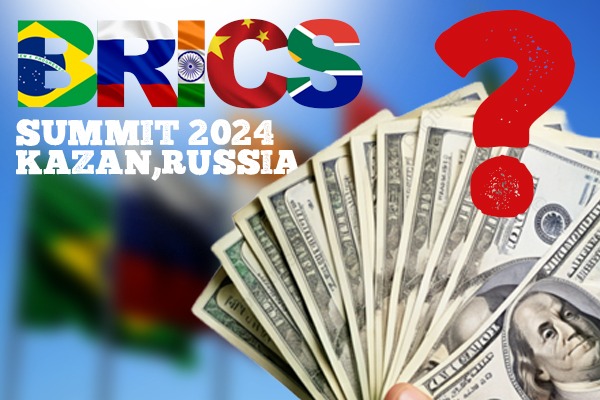The 16th BRICS Summit, convened in Kazan, Russia, in October 2024, marked a significant turning point for the bloc, particularly regarding its aspirations for global economic reform. Under the banner of “Strengthening Multilateralism for Fair Global Development and Security,” the summit brought together nine key BRICS members—Brazil, Russia, India, China, South Africa, along with the newly welcomed nations from the 2023 expansion: Saudi Arabia, UAE, Egypt, Iran, and Ethiopia. A major focus of the discussions was the bloc’s de-dollarization strategy, which aims to diminish dependence on the U.S. dollar in international trade. This long-discussed initiative gained prominence as BRICS countries explored alternatives, including the increased use of local currencies and the potential creation of a common BRICS currency.
The summit featured prominent leaders, including Russian President Vladimir Putin, Chinese President Xi Jinping, Indian Prime Minister Narendra Modi, South African President Cyril Ramaphosa, Egyptian President Abdel Fattah el-Sisi, Ethiopian Prime Minister Abiy Ahmed, Iranian President Masoud Pezeshkian, UAE President Mohammed bin Zayed Al Nahyan, and Brazilian Foreign Minister Mauro Luiz Iecker Vieira.
The Movement Towards De-dollarization
The recent summit highlighted the growing momentum behind de-dollarization, with Russia and China leading the charge to diminish the U.S. dollar’s supremacy. This shift has gained urgency following the economic sanctions levied against Russia after its invasion of Ukraine. Both nations are actively exploring alternatives to the dollar for international transactions and financial exchanges. A significant proposal that emerged from the discussions was the establishment of a “petroyuan,” which could potentially disrupt the longstanding dominance of the petrodollar in the global energy sector. This initiative aims to facilitate oil transactions, particularly among BRICS countries, using the Chinese yuan instead of the dollar.
Additionally, the idea of a BRICS Central Bank Digital Currency (CBDC) was proposed. This digital currency would streamline and secure cross-border payments among BRICS nations, reducing reliance on Western financial systems like SWIFT. There has already been a notable shift towards local currency settlements in bilateral trade, with countries such as India and Russia successfully moving some transactions away from the dollar.
Nevertheless, the path to widespread acceptance of a non-dollar settlement system is fraught with challenges. Economic disparities within BRICS pose significant obstacles; for instance, India’s considerable trade deficits with China make it hesitant to fully embrace a yuan-based framework. Furthermore, the instability of Chinese financial markets, particularly in areas like real estate, raises questions about the yuan’s reliability as a global currency.

Expansion and Geopolitical Influence
The recent summit marked a significant turning point for BRICS, particularly with the inclusion of new members like Saudi Arabia, the UAE, and Iran. This expansion is seen as a pivotal move to enhance the bloc’s economic power, especially considering Saudi Arabia’s status as a leading oil producer and the UAE’s strategic position as a global trade hub. For Russia, welcoming these Middle Eastern nations is not just an economic maneuver but a crucial geopolitical strategy, bolstering its influence in a region where it faces increasing isolation from Western powers.
Yet, this diversification of membership brings its own set of challenges. Iran’s ongoing struggle with U.S. sanctions adds a layer of complexity to the BRICS+ dynamics, particularly given its historically tense relations with both Saudi Arabia and the UAE. Navigating these internal disparities will be essential for BRICS if it aims to maintain a unified stance on critical issues such as financial reform and global governance.
Economic and Strategic Goals
A key focus of the summit was the aspiration to solidify BRICS as a more integrated economic entity. Central to this ambition is the New Development Bank (NDB), often referred to as the BRICS Bank. Discussions at the summit emphasized the importance of providing loans to member and partner nations in local currencies, a strategy designed to diminish reliance on the U.S. dollar. This initiative aligns with a broader objective to foster infrastructure development throughout the Global South, which is a cornerstone of BRICS’ mission.
Moreover, BRICS is intent on expanding its influence in global markets beyond just finance. A notable proposal from Russia involves establishing a BRICS grain exchange, which would directly challenge the dominance of U.S.-based platforms in the pricing of agricultural commodities. Given that BRICS countries account for nearly half of the world’s grain production, this initiative could empower these nations to exert greater control over pricing and trading conditions.
Challenges
While the aspirations of BRICS are commendable, the reality is that many of its objectives may not come to fruition in the immediate future. The internal disagreements within the group—especially regarding the potential establishment of a BRICS currency and the level of financial integration—have led experts to suggest that significant advancements will be gradual. For instance, although Russia has been advocating for a quicker shift away from the dollar, other member nations exhibit considerable reluctance about how far they are prepared to distance themselves from the Western financial framework.
Additionally, the economic hurdles faced by some of the newer entrants, like Egypt and Ethiopia, could hinder the group’s capacity to concentrate on overarching financial reforms while simultaneously addressing the urgent developmental challenges these countries encounter. This situation complicates BRICS’ ambitions of creating an alternative financial system.
In summary, the 2024 BRICS Summit underscored the bloc’s escalating desire to transform the global financial landscape by diminishing dependence on the U.S. dollar. Although notable progress was achieved in promoting the de-dollarization initiative—evident in discussions surrounding a petroyuan, local currency transactions, and digital currencies—the journey ahead is laden with obstacles. The success of BRICS’ long-term objectives will hinge on overcoming internal rifts, navigating geopolitical tensions, and fostering greater unity among its increasingly diverse membership. Nevertheless, the summit has reinforced BRICS’ position as a significant force in the shifting dynamics of global governance and economics.








